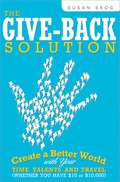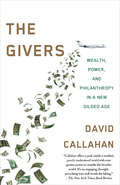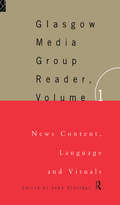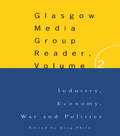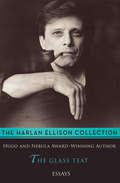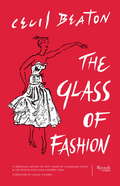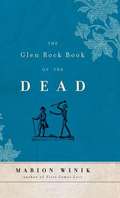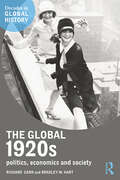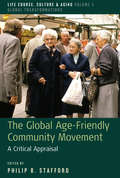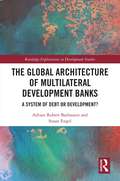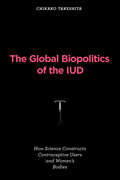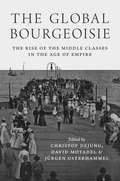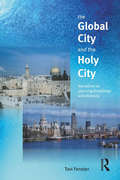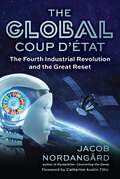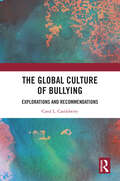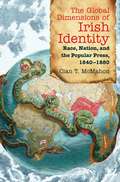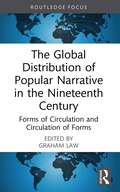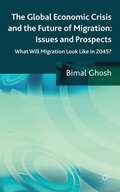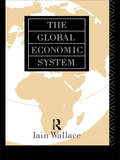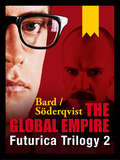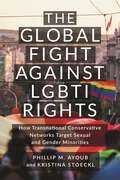- Table View
- List View
The Give-back Solution
by Susan SkogAn unprecedented surge of ordinary people are using their time, talents, and travel to make a better world. What's Your Part of the Give-Back Solution? Reaching out and supporting others brings out the best in all of us. Giving back strengthens America-but the under-appreciated secret is that it lifts us up, too. Part call-to-action, part inspiration, part practical research guide to make-a-difference opportunities, The Give-Back Solution captures the idealism and generosity sweeping our country, even in the face of serious challenges. Dance to raise money for fighting malaria Organize an office book drive Build schools in Belize on a volunteer vacation Invite friends over for a dinner that benefits the hungry Visit the Amazon and support sustainable rainforests Work in a Kenyan orphanage Clear trails in America's wilderness Clean up rivers in your own backyard Micro-bankroll an African entrepreneur climbing out of poverty Use your 9-to-5 experience to teach business skills in your community or online With amazing stories of everyday volunteers having the time of their lives giving back, social change leader Susan Skog shows how you can join the groundswell of goodwill, whether you volunteer abroad or support efforts locally, and whatever your time, talents, or resources.
The Givers: Wealth, Power, and Philanthropy in a New Gilded Age
by David CallahanAn inside look at the secretive world of elite philanthropists--and how they're quietly wielding ever more power to shape American life in ways both good and bad. While media attention focuses on famous philanthropists such as Bill Gates and Charles Koch, thousands of donors are at work below the radar promoting a wide range of causes. David Callahan charts the rise of these new power players and the ways they are converting the fortunes of a second Gilded Age into influence. He shows how this elite works behind the scenes on education, the environment, science, LGBT rights, and many other issues--with deep impact on government policy. Above all, he shows that the influence of the Givers is only just beginning, as new waves of billionaires like Mark Zuckerberg turn to philanthropy. Based on extensive research and interviews with countless donors and policy experts, this is not a brief for or against the Givers, but a fascinating investigation of a power shift in American society that has implications for us all.From the Hardcover edition.
The Glasgow Media Group Reader, Vol. I: News Content, Langauge and Visuals
by John EldridgeFirst Published in 1995. Routledge is an imprint of Taylor & Francis, an informa company.
The Glasgow Media Group Reader, Vol. II: Industry, Economy, War and Politics
by Greg PhiloFirst Published in 1995. Routledge is an imprint of Taylor & Francis, an informa company.
The Glass Teat: Essays (Edgeworks Ser. #Vol. 5)
by Harlan EllisonIn the late 1960s Harlan Ellison, launched a weekly column for the Los Angeles Free Press, where he uncompromisingly discussed the effects of television on modern society. He assaulted everything from television sitcoms to corrupt politicians, talk shows to military massacres. Today, more than four decades later, almost all of his criticism still holds true.Open Road and Edgeworks Abbey, Ellison's company, are proud to make this first volume of fifty-two outspoken columns widely available. Do not miss the second volume, The Other Glass Teat.
The Glass of Fashion
by Cecil Beaton Hugo VickersGorgeously repackaged, this reissue of the classic book presents the iconic photographer's expert and witty reminiscences of the personalities who inspired fashion's golden eras, and left an indelible mark on his own sense of taste and style. "The camera will never be invented that could capture or encompass all that he actually sees," Truman Capote once said of Cecil Beaton. Though known for his portraits, Beaton was as incisive a writer as he was a photographer. First published in 1954, The Glass of Fashion is a classic--an invaluable primer on the history and highlights of fashion from a man who was a chronicler of taste, and an intimate compendium of the people who inspired his legendary eye. Across eighteen chapters, complemented by more than 150 of his own line drawings, Beaton writes with great wit about the influence of luminaries such as Chanel, Balenciaga, and Dior, as well as relatively unknown muses like his Aunt Jessie, who gave him his first glimpse of "the grown-up world of fashion." Out of print for decades but recognized and sought after as a touchstone text, The Glass of Fashion will be irresistible to a new generation of fashion enthusiasts and a seminal book in any Beaton library. It is both a treasury and a treasure.
The Glen Rock Book of the Dead
by Marion WinikIn her author's note, Marion Winik writes that in Mexico on the Day of the Dead, "people build altars to their loved ones ... they go to the cemetery and stay all night, praying, singing, drinking, wailing. They tell the sad stories and the noble ones; they eat cookies shaped like skeletons. They celebrate and mourn at once." Striking that balance, The Glen Rock Book of the Dead presents snapshot portraits of The Jeweler, The Driving Instructor, The Bad Influence, The Queen of New Jersey--and roughly fifty others who have touched Winik's life, from her son's second grade teacher to Keith Haring. Tied together by the inimitable, poignant voice of Winik, these losses form not only an autobiography but a story of our time, delivering a lyrical journey that ultimately raises the spirits.
The Global 1920s: Politics, economics and society (Decades in Global History)
by Richard Carr Bradley W. HartThe 1920s is often recognised as a decade of fascism, flappers and film. Covering the political, economic and social developments of the 1920s throughout the world, The Global 1920s takes an international and cross-cultural perspective on the critical changes and conditions that prevailed from roughly 1919 to 1930. With twelve chapters on themes including international diplomacy and the imperial powers, film and music, art and literature, women and society, democracy, fascism, and science and technology, this book explores both the ‘big’ questions of capitalism, class and communism on the one hand and the everyday experience of citizens around the globe on the other. Utilising archival sources throughout, it concludes with an extensive discussion of the circumstances surrounding the 1929 stock market crash and the onset of the Great Depression, the effects of which were felt worldwide. Covering topics from the oil boom in South America to the start of civil war in China, employment advances and setbacks for women across the globe, and the advent of radio and air travel, the authors provide a concise yet comprehensive overview of this turbulent decade. Containing illustrations and a selection of discussion questions at the end of each chapter, this book is valuable reading for students of the 1920s in global history.
The Global Age-Friendly Community Movement: A Critical Appraisal (Life Course, Culture and Aging: Global Transformations #5)
by Philip B. StaffordThe age-friendly community movement is a global phenomenon, currently growing with the support of the WHO and multiple international and national organizations in the field of aging. Drawing on an extensive collection of international case studies, this volume provides an introduction to the movement. The contributors – both researchers and practitioners – touch on a number of current tensions and issues in the movement and offer a wide-ranging set of recommendations for advancing age-friendly community development. The book concludes with a call for a radical transformation of a medical and lifestyle model of aging into a relational model of health and social/individual wellbeing.
The Global Architecture of Multilateral Development Banks: A System of Debt or Development? (Routledge Explorations in Development Studies)
by Susan Engel Adrian Robert BazbauersThis book explores the evolution of the 30 functioning multilateral development banks (MDBs). MDBs have their roots in the growing system of international finance and multilateral cooperation, with the first recognisable MDB being proposed by Latin America in financial cooperation with the US in the late 1930s. That Inter-American Bank did not eventuate but was a precursor to the World Bank being negotiated at Bretton Woods in 1944. Since then, a complex network of regional, sub-regional, and specialised development banks has progressively emerged across the globe, including two significant recent entrants established by China and the BRICS. MDBs arrange loans, credits, and guarantees for investment in member states, generally with the stated aim of fostering economic growth. They operate in both the Global North and South, though there are more MDBs focusing on emerging and developing states. While the World Bank and some of the larger regional banks have been scrutinised, little attention has been paid to the smaller banks or the overall system. This book provides the first study of all 30 MDBs and it evaluates their interrelationships. It analyses the emergence of the MDBs in relation to geopolitics, development paradigms and debt. It includes sections on each of the banks as well as on how MDBs have approached the key sectors of infrastructure, human development, and climate. This book will be of particular interest to researchers of development finance, global governance, and international political economy.
The Global Biopolitics of the IUD
by Chikako TakeshitaThe intrauterine device (IUD) is used by 150 million women around the world. It is the second most prevalent method of female fertility control in the global South and the third most prevalent in the global North. Over its five decades of use, the IUD has been viewed both as a means for women's reproductive autonomy and as coercive tool of state-imposed population control, as a convenient form of birth control on a par with the pill and as a threat to women's health. In this book, Chikako Takeshita investigates the development, marketing, and use of the IUD since the 1960s. She offers a biography of a multifaceted technological object through a feminist science studies lens, tracing the transformations of the scientific discourse around it over time and across different geographies. Takeshita describes how developers of the IUD adapted to different social interests in their research and how changing assumptions about race, class, and female sexuality often guided scientific inquiries. The IUD, she argues, became a "politically versatile technology," adaptable to both feminist and nonfeminist reproductive politics because of researchers' attempts to maintain the device's suitability for women in both the developing and the developed world. Takeshita traces the evolution of scientists' concerns, from contraceptive efficacy and product safety to the politics of abortion and describes the most recent, hormone-releasing, menstruation-suppressing iteration of the IUD. Examining fifty years of IUD development and use, Takeshita finds a microcosm of the global political economy of women's bodies, health, and sexuality in the history of this contraceptive device.
The Global Biopolitics of the IUD: How Science Constructs Contraceptive Users and Women's Bodies (Inside Technology)
by Chikako TakeshitaThe biography of a multifaceted technological object, the IUD, illuminates how political contexts shaped contraceptive development, marketing, use, and users. The intrauterine device (IUD) is used by 150 million women around the world. It is the second most prevalent method of female fertility control in the global South and the third most prevalent in the global North. Over its five decades of use, the IUD has been viewed both as a means for women's reproductive autonomy and as coercive tool of state-imposed population control, as a convenient form of birth control on a par with the pill and as a threat to women's health. In this book, Chikako Takeshita investigates the development, marketing, and use of the IUD since the 1960s. She offers a biography of a multifaceted technological object through a feminist science studies lens, tracing the transformations of the scientific discourse around it over time and across different geographies. Takeshita describes how developers of the IUD adapted to different social interests in their research and how changing assumptions about race, class, and female sexuality often guided scientific inquiries. The IUD, she argues, became a “politically versatile technology,” adaptable to both feminist and nonfeminist reproductive politics because of researchers' attempts to maintain the device's suitability for women in both the developing and the developed world. Takeshita traces the evolution of scientists' concerns—from contraceptive efficacy and product safety to the politics of abortion—and describes the most recent, hormone-releasing, menstruation-suppressing iteration of the IUD. Examining fifty years of IUD development and use, Takeshita finds a microcosm of the global political economy of women's bodies, health, and sexuality in the history of this contraceptive device.
The Global Bourgeoisie: The Rise of the Middle Classes in the Age of Empire
by Christof Dejung Jürgen Osterhammel David MotadelThe first global history of the middle class While the nineteenth century has been described as the golden age of the European bourgeoisie, the emergence of the middle class and bourgeois culture was by no means exclusive to Europe. The Global Bourgeoisie explores the rise of the middle classes around the world during the age of empire. Bringing together eminent scholars, this landmark essay collection compares middle-class formation in various regions, highlighting differences and similarities, and assesses the extent to which bourgeois growth was tied to the increasing exchange of ideas and goods. The contributors indicate that the middle class was from its very beginning, even in Europe, the result of international connections and entanglements.Essays are grouped into six thematic sections: the political history of middle-class formation, the impact of imperial rule on the colonial middle class, the role of capitalism, the influence of religion, the obstacles to the middle class beyond the Western and colonial world, and, lastly, reflections on the creation of bourgeois cultures and global social history. Placing the establishment of middle-class society into historical context, this book shows how the triumph or destabilization of bourgeois values can shape the liberal world order.The Global Bourgeoisie irrevocably changes the understanding of how an important social class came to be.
The Global City and the Holy City: Narratives on Knowledge, Planning and Diversity
by Tovi FensterThe Global City & the Holy City explores the local embodied knowledge of women and men of different national, cultural and ethnic identities and age groups, living in London and Jerusalem. Their narratives focus on the three main concepts of Comfort, Belonging and Commitment to the various spaces in which they live. By deconstructing the meanings of these three notions and analyzing their expression in cognitive temporal maps, The Global City & The Holy City examines the practicalities of incorporating this kind of local embodied knowledge into the professional planning and management of cities in the age of globalization.
The Global Coal Market
by Mark C. Thurber Thurber, Mark C. and Morse, Richard K. Richard K. MorseCoal has been the world's fastest-growing energy source in absolute terms for over a decade. Coal also emits more CO2 than any other fossil fuel and contributes to serious air pollution problems in many regions of the world. If we hope to satisfy the demand for affordable energy in emerging economies while protecting the environment, we need to develop a keen understanding of the market that supplies coal. This book offers an in-depth analysis of the key producers and consumers that will most influence coal production, transport, and use in the future. By exploring how countries such as China, India, Indonesia, Australia and South Africa have developed their respective coal industries - and how these industries link together through the international coal trade - experts shed light on how the global coal market may evolve, and the economic and environmental implications. This book is the most comprehensive treatment of these topics to date and will appeal to a wide readership, including scholars and practitioners working on energy economics and policy.
The Global Coup d'État: The Fourth Industrial Revolution and the Great Reset
by Jacob NordangårdWe are in the midst of a devastating takeover of our world. The Global Coup d'État shows how, why, and what we can do to stop it. The year 2020 will go down in history as the year when the global coup d'état was initiated. In a historical context, the COVID-19 crisis, the murder of George Floyd by a police officer and subsequent riots, mass protests against government lockdowns, and the 2020 election appear rather as part of a well-directed chess game, with complete control of the whole planet as the final goal. During the crescendo of this drama, the powers behind the coup emerged quite openly, offering a techno–totalitarian and very far-reaching solution to the world. This solution, which they call the Great Reset, means that mankind must be fully integrated and merged with a worldwide technological system, through the application of the technologies of the Fourth Industrial Revolution—all for our own safety, security, and well-being. Most people probably associate the phrase &“coup d'état&” with a sudden, violent takeover, with tanks around government buildings, takeover of media channels, purges of dissidents, arrests, and so on. But this is not always the case. The usurpers can also seize power without violence, in a completely legal and democratic way, with the consent or even enthusiasm of the people, as evidenced in 2020. There are many &“existential threats&” (climate crisis, refugee crises, terrorism, pandemics, etc.) that can be used to establish a firmer and more centralized governance. This can be a gradual process, barely perceivable until it&’s almost a fait accompli. In The Global Coup d'État, author and researcher Jacob Nordangård shares the history, describes the process, reveals the methods, and identifies the agents of this worldwide takeover so that we can take action before it is too late.
The Global Crisis and Transformative Social Change
by Shahra Razavi Peter Utting Rebecca Varghese BuchholzGlobal crises not only deeply impact the economy and people's livelihoods, they also unsettle basic ideas and assumptions about the meaning and drivers of development. This collection of theoretical and empirical studies explores the substance and politics of policy change following the 2007/8 crisis from the perspective of developing countries.
The Global Culture of Bullying: Explorations and Recommendations
by Carol CastleberryThis book explicates “bullying” as a concept and as a social and cultural phenomenon that has become a defining reality of the times in which we live. The author begins in the arena where it is first, and most acutely individually, experienced—in school—and expands to other institutions and areas of social life—the family, the workplace, and the local, national, and international spheres, extending the concept of bullying to the global arena to uncover the social and institutional root causes of the extreme forms of bullying such as trafficking, torture, terrorism, and genocide. The book discusses the steps taken to address these issues and analyzes their efficacy. It explores the concept of epigenetics, brain development, childhood experiences, and other psychological factors that contribute to bullying behaviors and predispositions. The book investigates and compares anti-bullying and anti-violence initiatives taken particularly in the U.S, the U.K., and India to address the issue and create community-wide resilience practices. It also describes the current trends in decisions from international, regional, and domestic law, and offers evidence-based policy recommendations to establish a culture of respect for human dignity. An interdisciplinary, intercultural exploration, and analysis of the phenomenon of bullying, this book will be of interest to students, teachers, and researchers of psychology, sociology, anthropology, social justice and law, human rights, and cultural studies. It will also be useful for academic libraries, academicians, policy planners, school administration, government officials, and readers interested in reading about bullying.
The Global Dimensions of Irish Identity
by Cian T. McmahonThough Ireland is a relatively small island on the northeastern fringe of the Atlantic, 70 million people worldwide--including some 45 million in the United States--claim it as their ancestral home. In this wide-ranging, ambitious book, Cian T. McMahon explores the nineteenth-century roots of this transnational identity. Between 1840 and 1880, 4.5 million people left Ireland to start new lives abroad. Using primary sources from Ireland, Australia, and the United States, McMahon demonstrates how this exodus shaped a distinctive sense of nationalism. By doggedly remaining loyal to both their old and new homes, he argues, the Irish helped broaden the modern parameters of citizenship and identity.From insurrection in Ireland to exile in Australia to military service during the American Civil War, McMahon's narrative revolves around a group of rebels known as Young Ireland. They and their fellow Irish used weekly newspapers to construct and express an international identity tailored to the fluctuating world in which they found themselves. Understanding their experience sheds light on our contemporary debates over immigration, race, and globalization.
The Global Distribution of Popular Narrative in the Nineteenth Century: Forms of Circulation and Circulation of Forms (Routledge Focus on Literature)
by Graham LawThe principal aim of this collection of articles is to explore the evolving generic patterns and the modes of transnational distribution of popular narrative over the course of the nineteenth century. This volume addresses networks of reception drawn around cities as diverse as Constantinople, Moscow, and Tokyo, with a focus on peripheries in South and West Asia, and Northern as well as Eastern Europe; in generic terms, there are specific investigations of shipwreck narratives, satirical cartoons, press reports, orally transmitted folklore, traditional sacred tales, and adventure novels. It combines the materialist approach of book/media history with the aesthetic insights of literary and cultural studies, drawing inspiration from the seminal work of scholars such as Benedict Anderson, Franco Moretti, Pascale Casanova, and Arjun Appadurai.
The Global Economic Crisis and the Future of Migration: Issues and Prospects
by Bimal GhoshThe reason for the depth the 2008's global depression lies in the intractability of modern economic systems. This has led to an emergence of unprecedented migratory patterns, the analysis and management of which is key to economic recovery.
The Global Economic System
by I. WallaceThe author provides a treatment of world economic geography as a whole. He sets out the historical context of the modern world along with the principal philosophies that have shaped our study of it, and identifies the importance of the biophysical environment as well as cultural and political settings for economic activity.
The Global Empire: Futurica Trilogy 2
by Alexander Bard Jan SöderqvistWhen the foundations of society goes through revolutionary changes, caused by new communication technologies, there will be consequences. <P><P> The old political conflicts and the old political ideologies disappear, replaced by new patterns that initially will be difficult to discern and to interpret...
The Global Environmental Crisis: The Limitations of Scientific Knowledge and the Necessity of Utopian Imagination
by John LieThe Global Environmental Crisis presents a new perspective on our inattention and inaction in the face of a major crisis. We cannot proceed without scientific knowledge, but we cannot exclusively rely on it. What we need, in addition to scientific knowledge, is utopian imagination to make us understand the nature of the crisis and to suggest an alternative vision of a viable future. This book is an essential resource for students and instructors across the social sciences, especially sociology and environmental studies. It will also be a crucial and accessible text for general readers interested in climate change and how to imagine a better world for themselves and future generations.
The Global Fight Against LGBTI Rights: How Transnational Conservative Networks Target Sexual and Gender Minorities (LGBTQ Politics)
by Phillip M. Ayoub Kristina StoecklAn in-depth look at the global movement to curtail LGBTI rights—and how the LGBTI movement responds to itIn the past three decades, remarkable progress has been made in numerous countries for the rights of individuals marginalized due to their sexual orientation and gender identity. The advancements in LGBTI rights can largely be attributed to the tireless efforts of the transnational LGBTI-rights movement, forward-thinking governments in pioneering nations, and the evolving human rights frameworks of international organizations. However, this journey towards equality has been met with formidable opposition. An increasingly interconnected and globally networked resistance, backed by religious-nationalist elements and conservative governments, has emerged to challenge LGBTI and women's rights, even seeking to reinterpret and co-opt international human rights law.In The Global Fight Against LGBTI Rights, authors Phillip M. Ayoub and Kristina Stoeckl investigate this complex landscape, drawing from over a decade of in-depth fieldwork and over 240 interviews with LGBTI activists, anti-LGBTI proponents, and various state and international organization actors. The authors explore the mechanisms and strategies employed by the conservative transnational movement, seeking to understand its composition and the construction of its agenda.With a wealth of empirical evidence and insightful analysis, this book is a valuable resource for scholars, policymakers, activists, and anyone interested in understanding the ongoing global battle for LGBTI rights.
